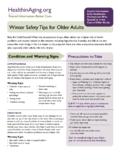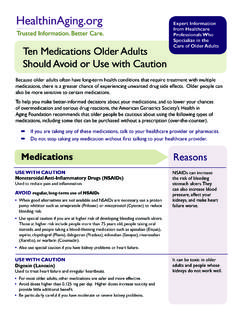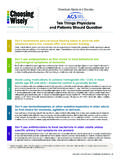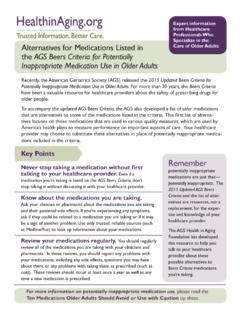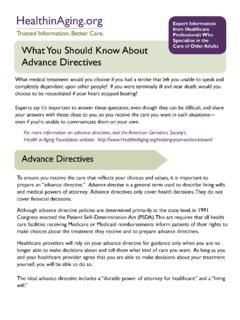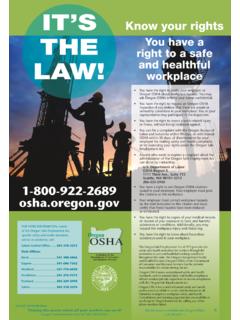Transcription of Choosing the Right Cane or Walker - Health in Aging
1 Choosing the Right cane or WalkerCanes and walkers help people with pain, weakness, and balance problems walk more safely and comfortably. They also may help some people avoid falls. There are many different types of canes, walkers, and other assistive devices available, so it s very important to 1) work with a healthcare provider (physical therapist, doctor, nurse) to choose the correct type of walking aid for you, 2) have the cane or Walker sized so it fits you correctly, and 3) get help learning how to use it the Right wayIn most cases, canes and walkers are reimbursable through Medicare and other Information from Healthcare Professionals Who Specialize in the Care of Older AdultsWhich Should I Choose?CanesWalkersWhat is the main reason you need the device?Arthritis or pain, especially of the knees and hips, and on one balance to one foot or or pain (especially of the knees and hips) on both to bad balance and gait weakness or weakness of both much of your weight does the device need to support?
2 You can support up to 25% of your weight with a can support up to half of your weight with some common types Single point canes can help with early balance problems. Four point or quad canes add more stability and help even more with balance. Seat canes have small attached seats so you can take a rest while using it. Standard walkers need to be picked up to move forward. Front-wheeled walkers don t need to be picked up, so they use less energy. Rolling 4-wheeled walkers give support and come with or without seats and things to think about All canes must have a non-skid rubber tip. Curved, rounded, or grip handles help with balance and to lower stress on your hand. Canes are not as stable as walkers. Walkers should have rubber grips for your hands so they don t slip. Front-weeled walkers must have non-skid tips on the back legs. Walkers cannot be used on you feel you need a cane or Walker , talk to your healthcare provider to make sure you get the device that is best for you.
3 When deciding between a cane or Walker , discuss the following points with your healthcare provider:For more information, download our free Tip Sheet on Falls Prevention available at to Get a Proper Fit for Your cane or Walkern Wear your normal Let your arm hang loosely at your side. n Ask someone else to measure the distance from your wrist to the This measurement should be about the same as the distance from the floor to the point where your leg bone fits into your hip Have your cane or Walker adjusted so that the top of it is that same distance from the floor. n Aluminum canes and most walkers are adjusted by pushing in buttons on each side and sliding the tubing to the new length until the buttons lock in Wood canes can be cut to size. n Put your hand on the cane or Walker handle. If the length is correct, you will notice a 20-degree to 30-degree bend in the elbow.
4 (If your upper arm is at 12 o clock, your hand points to 5 o clock.)The correct length of a cane or Walker is measured from the wrist to the floor. To measure:If your cane or Walker does not feel Right , ask your physician or physical therapist to check the Steps to Safely Using Your Cane1 . Use the cane on the opposite side of your injury, pain, or weakness (unless your healthcare provider tells you not to).2 . Put all of your weight on your good . Move the cane and your bad leg a comfortable distance . With your weight supported on both your cane and your bad leg, step through with your good . Place your cane firmly on the ground before you take a step. Do not place your cane too far ahead of you, or it could slip from under Steps to Safely Using Your Cane1 . Stand with your toes halfway between the front and back tips or wheels.
5 Roll or lift your Walker a step s length ahead of you. 2 . Place the Walker firmly on the ground. Do not place your Walker too far ahead of you, or it could slip from under . Lean slightly forward, and hold the arms of the Walker for . Take a . Repeat the cycle: Place your Walker firmly on the ground (or roll it ahead of you), then take a rubber tips help keep you from slipping. Check tips often and change them if they look worn. These tips are available through your local pharmacy or medical supply carpeted surfaces, tennis balls cut and placed on the rubber tips can be helpful for ease of movement. Get Non-Skid Rubber Tips for Your cane or Walker5 Steps to Safely Using Your WalkerDISCLAIMER: This information is not intended to diagnose Health problems or to take the place of medical advice or care you receive from your physician or other healthcare provider.
6 Always consult your healthcare provider about your medications, symptoms, and Health problems. January 2016 2016 Health in Aging Foundation. All rights reserved. This material may not be reproduced, displayed, modified, or distributed without the express prior written permission of the copyright holder. For permission, contact

